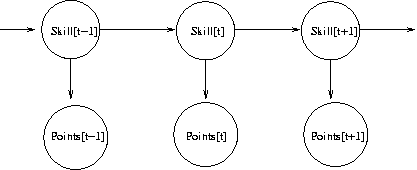
One problem in intelligent tutoring systems is that the tests do
not tell the students' real skills. Especially in yes/no questions,
the students can get good points by guessing. One solutions is to
calculate the probability of mastering a skill, given the test points
measuring this skill. In addition, we can utilize temporal
information: if the student mastered a skill in the previous time
step, s/he will quite probably master it now, too. On the other hand,
if the student did not master the skill in the past, then every
correct answer increases the probability to master it.

Let's model the problem by a very simple HMM. There are only two hidden states: either the student masters a skill on time step t (S[t]=1) or doesn't (S[t]=0). The observed answers are either correct (O[t]=1) or false (O[t]=0). The probabilities are following:
Transition probabilities:
P(S[t]=1|S[t-1]=1)=0.99
P(S[t]=1|S[t-1]=0)=0.10
P(S[t]=0|S[t-1]=1)=0.001
P(S[t]=0|S[t-1]=0)=0.90
Observation probalities:
P(O[t]=1|S[t]=1)=0.90
P(O[t]=1|S[t]=0)=0.10
P(O[t]=0|S[t]=1)=0.10
P(O[t]=0|S[t]=0)=0.90
a) If P(S[0]=1)=0.20 and O[1]=0, what is P(S[1]=1)?
b) What is P(S[2]=1)?
c) What is P(S[2]|O[2]=1)? (I.e. updated probability of P(S[2]=1),
when we have observed O[2]=1.)